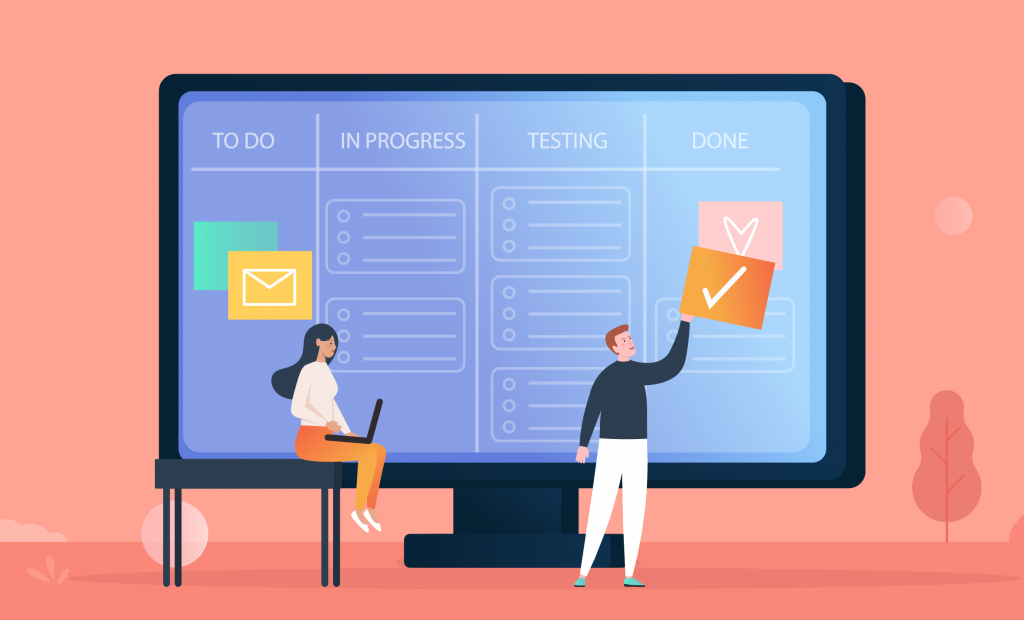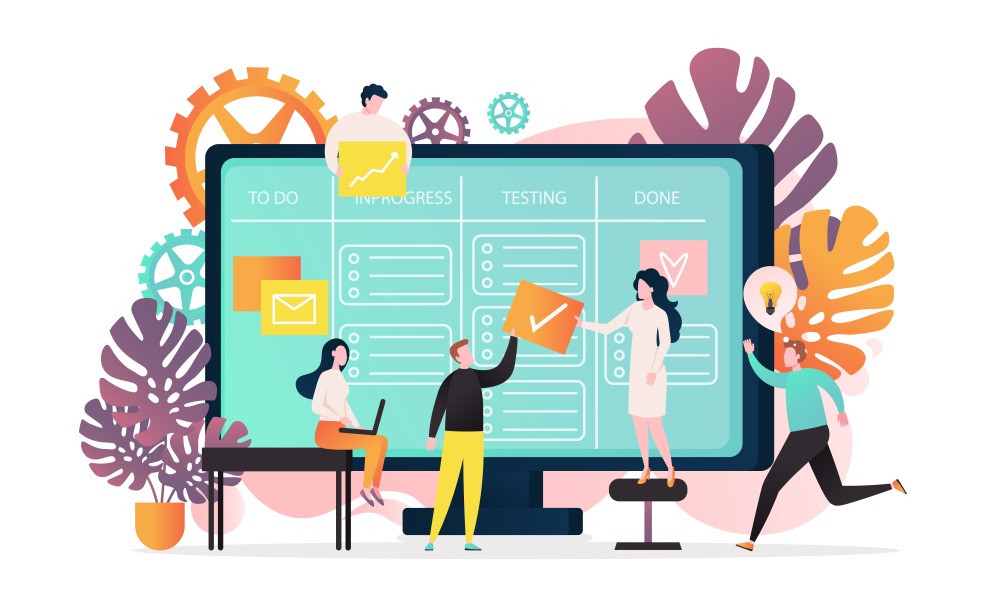Nowadays, many companies, organizations, and individuals are becoming more aware of the importance of technological factors in all aspects of life. This situation has resulted in the increasing need for different software products and services that cannot be created successfully without a proper software project management plan.

Whether you’re currently an experienced software project manager, an ambitious team member in a software project, or still very much in the dark about it, this article from Designveloper will offer something helpful. Specifically, you’ll know something about project management steps and how to make an effective project management plan.
Software Project Management Overview
Project management refers to the process of applying skills, knowledge, techniques, and tools to project activities to fulfill the requirements of the project. It is usually broken down into project management phases, including project initiation, project planning, project execution, project monitoring, and project closure.

So what is software project management? Actually, it refers to the branch of project management that involves planning, scheduling, allocating resources, executing, tracking, and delivering specific software and other IT-related projects within the minimum possible consumption of resources, time, and money.
Building a Software Project Management Plan
As shown above, planning is one of the five project management steps. Just when the software project can approve, it needs a project plan to give direction to the whole team in terms of product scope, resources and material required, quality outputs, potential risks management, and costs throughout the project.
1. Performing requirement gathering
The first step in building a software project management plan is requirement gathering. It is about the exploratory research and documentation of the customers’ project requirements to provide them with what they want. The requirements gathering process can conduct at the very beginning of the software project.
This phase can determine the success or failure of any software and IT-related project. More specifically, if you cannot get a correct requirement identification of deadlines, scope, and cost overrun at the outset, all these elements will negatively impact the project’s progress. In fact, over 70% of failed projects resulted from the flawed requirements-gathering process.
Indeed, there are multiple ways to gather requirements. Software project managers can utilize methods such as conducting a pre-workshop survey, adopting the nominal group technique, organizing brainstorming sessions, or having one-on-one talks with those involved. Importantly, whatever means they use, they need to select the best method mix that is beneficial for the project.
2. Planning for software project risks
The project risks can be unexpected and rampant, ranging from insufficient time and budget. Unrealistic stakeholders’ expectations of software quality standards and human resource issues. Thus, the identification, quantification, and response to the risk potentials to mitigate their impacts are essential in the project management phases.
Irrespective of their company’s official risk management plan, software project managers and his project team have to identify accurately and quickly the project risks. This can be achieved by using both quantitative and qualitative risk analyses, but the former is more suitable for large projects with longer durations and more money at stake.
Recommended reading: SDLC Waterfall Model: Definition, Phases, and Pros & Cons
Besides, the risk response plan plays a vital role in risk management since it contains a list of identified risks. Their impacts and the measures to address them. Remember that the risk response plan needs regularly updating to make risk information current because risks are unexpected during the project and can vary from time to time.
3. Building a software project quality plan
Project quality refers to the project’s deliverables and ability to meet the specified and implied requirements. There are three interrelated constraints (project scope, cost, and time) that determine the quality of a project. As can be seen in the Iron Triangle below, three triangles’ sides correspond to three constraints. Any change in one constraint will make the two remaining ones change. And the quality in the middle is affected accordingly.

Therefore, as a software project manager. You can suppose to determine the project scope connected with the cost and required schedule. Then you need to examine the expenses needed for the achievement of the expected quality level. In some cases, you have to consider the profit margin expected to gain your software project’s optimal quality level.
Moreover, it would help if you had a quality assurance or defect prevention plan. Which is one of the most necessary things for any software project. It ensures that your project’s satisfactory level will obtain through the validation. And verification of the work products after each software product phase. Only when they satisfy the expected quality level can the project be permitted to move forward.
4. Selecting software project team members
A software project is a collaborative activity performed by people, and they are those in your project team. You need a project team for planning, estimating, execution, and project completion. They need you to lead the project until the end and protect them from stakeholders’ badgering.
To determine all necessary resources for the project, you can consult those experienced in software and IT-related products. You can also refer to the resource database in your company. It will scan the resources and know people’s skill sets. And talents for your project team to be assembled quickly.

You can make a conversation with promising project team members about how you can help each other to create a win/win situation. The STAR is a method that can use to interview. This may give you an insight into a person’s qualifications, experience, achievements, strengths, and weaknesses.
5. Creating software project time estimates
The software project manager is also responsible for creating the time estimate as accurately as possible. A reasonable time estimate will help you be more prepared for any risks, and development delays. And time-consuming tasks so that the whole project can be implemented straightforwardly to the completion.
Creating a correct time estimate of how long the project will last is a time-consuming and challenging task. However, a work breakdown structure (WBS) and a project network diagram (PND). It helps to detail what should be conducted by both the project manager and the project team for the project completion.

In addition to Gantt charts, you can use PERT charts to achieve the correct time estimate. PERT is the only time-estimation technique with a built-in risk assessment level because outside of estimating the best-case scenario. The most likely time, it considers the worst situations that can occur for any activity.
Recommended reading: An Overview of Project Management Services
6. Estimating software project cost
A critical phase in software project management planning is recognizing. And understanding how much a project will cost for you to commit the funds. An accurate budget estimate should include the following: product and project scope, time frame, assumptions, constraints, and variance range.
Cost estimation helps the project manager explain all real costs to a stakeholder about a correct ballpark figure for the project. Though not all necessary information is available until the planning process. It won’t stop customers from asking cost questions requiring quick responses. Remember that poor cost estimates win little trust from the stakeholders.
You should also bear in mind that understanding your organization’s rules for estimating is essential before diving into the cost estimates. Some companies don’t have specific policy guidance on cost estimates. While others will offer some guidelines, to which you should conform. It’s also advisable for you to refer to historical information and cost estimating templates.
| FURTHER READING: |
| 1. Web Application Architecture: Types, Components, and Tools to Creates |
| 2. What is The Quality Assurance Process? |
Software Project Management Plan Example
To save time and effort, the software project manager can refer to any software project management plan examples on some websites. GanttPRO Instagantt and Projectmanager offer ready-made management plan templates that will be extremely helpful irrespective of your experience or organization size.
With the software project management plan example templates. You don’t need to worry about project tasks, project duration, those in charge, project progress, and so on. Thus, you can focus on your tasks, prevent risks, and meet all deadlines. And accordingly, proceed in all the project management phases.
In a nutshell, among the five project management phases. Building a software project management plan is the skeleton of any project software. As a software project manager, you can refer to our suggested steps above. To create a detailed management plan, ensure the smooth operation of your project team. And lead them to successful project completion.
The post Software Project Management Plan: Steps and Tips appeared first on Designveloper.
June 10, 2022 at 05:50PM













No comments:
Post a Comment